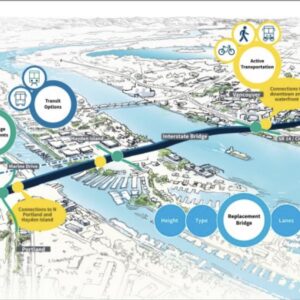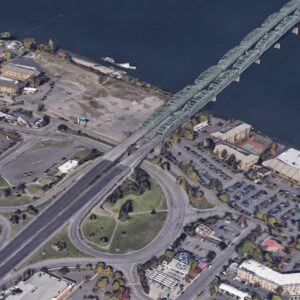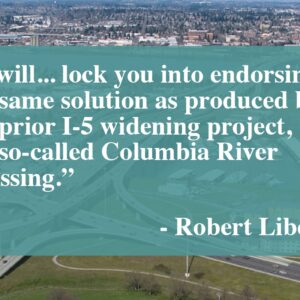Local scrutiny on the controversial, $3.6 billion Columbia River Crossing (CRC) project is heating up again ahead of a key Metro Council vote on the project Thursday.
At stake with the vote is whether or not to grant full approval of the locally preferred alternative Metro adopted back in 2008. At that time, Metro adopted the plans for the project; but there were several issues they said had to be addressed before they’d give it their full blessing.
The Bicycle Transportation Alliance (BTA) and the Coalition for a Livable Future (CLF), advocacy groups who have been tracking the project for years, both claim that those issues have not been addressed and now they are rallying troops in hopes that Metro will vote no on the project.
The BTA is urging their members to take action against the project, writing on their blog that the project is “irresponsible and costly” and that if it moves forward it would, “burden future generations with billions of dollars of debt for thirty years.”
The CLF has written Metro Council with a summary of the issues (initially outlined by Metro themselves) that project staff has failed to address. Mara Gross with CLF told us this morning that,
“Metro made clear that ODOT and their consultants needed to address a range of issues for Metro to approve the project. That hasn’t happened. Metro should stand their ground. The CRC cut community improvements, has a very risky financial plan, and can’t assure the region that other priorities won’t get cut.”
If Metro votes yes on Thursday, Gross fears they’d lose the authority to stop the project.
It’s not only activists that are sounding the alarm on the CRC.
Last week, the Willamette Week’s Pulitzer Prize-winning reporter Nigel Jaquiss published a scathing cover story on the project. In, A Bridge Too False, Jaquiss reported that many of the most important justifications for the bridge are “myths” that fall apart with greater scrutiny.
Two state lawmakers, Representatives Lew Frederick and Ben Cannon (both Portland Democrats), penned an editorial in The Oregonian this morning which called out major concerns with health impacts of the project:
“Now we’re proposing to make the situation even worse with massive new highway interchanges and a bridge that will funnel cars and trucks — and their pollution — into a traffic jam in North Portland. It is no wonder that a recent study characterized the proposed Columbia River Crossing project as “An Environmental Injustice.”
As the project reaches key regulatory milestones, even Metro Council seems to be aware of the magnitude of each decision from here on out. Metro’s own Nick Christensen reported on a Council work session on the CRC just last week.
At that meeting, Councilor Barbara Roberts likened the Thursday vote to a leap of faith, saying the project has reached a point where, “There is a requirement that you have some faith before you step off into the canyon.”
Councilor Carlotta Collette talked about the need for community enhancement funds to be set aside within the project budget (the CLF says the current CRC proposal includes no such funds). Collette also voiced concerns over a lack of confidence in tolling projections, which could fall sharply if vehicle traffic volumes continue to decline.
Metro Council President Tom Hughes is also worried about the funding picture and how Oregon’s $400 million share of the project could come at the expense of other transportation projects in the region.
The questions that have plagued the CRC project for years remain; but are those questions enough to muster the political will to say stand up and say “no”? So far, no regional agency has done that. All eyes will be on Metro Council Thursday. Stay tuned.





to think that anybody still images the current CRC proposals as a good idea makes baby Jesus cry…
PLEASE vote “NO” Metro Councilors!!!
Please write the metro Councillors!
Kelsey is the Regional Outreach Coordinator and is collecting responses and forwarding as appropriate:
kelsey.newell@oregonmetro.gov
She quickly responded saying that she was forwarding my comments to the council members and appending the public record of comments
Thanks for making it easy for me, Allan! I emailed Kelsey and I hope my councilor votes “No!”
I think the only people excited about this are huge construction companies, people who live in Vancouver “cus it’s cheeper” and freight companies. All of which reside outside of Portland. Failure of any politician or entity in the face of this disastrous plan is especially disheartening to this diehard democrat (lowercase “D”)
The current I-5 Interstate bridges are in good shape, and should last another 100 years or more. Get rid of the ramps / exits to hayden isle, and the stupid exit right off the bridge going north. Make one lane truck/freight only. I bet the bridge would cease being a choke point. Add a small local bridge to Janzten beach.
Making one lane truck only would increase congestion. The problem is not freight traffic, it is SOV commuters during rush hour. “Freight mobility” is just an excuse to expand the freeway for more SOVs. The forces behind this project care about freight mobility about as much as they care about bikes.
My only concern is that the 9.0 earthquake which everyone describes as imminent would reportedly destroy the existing I-5 bridge. Then again, I’ve read where the other major bridges would collapse as well. At least Oregon is, uh, consistent.
A $200 million retrofit will bring them up to standard. And you are correct, the Marquam bridge is in worse shape seismically than the existing columbia river bridges.
@Nick V
The Jaquiss article in the WW does a good job of addressing this point:
The problem here with the CRC is that it’ll suck up a huge amount of transportation funding that might otherwise go to these other bridges that are in even worse shape than the Interstate Bridge.
But with the CRC, while some of its funding would go to a half-mile of new bridge, much more of it would go into demolishing and expanding four miles of freeway and interchanges on either end of that bridge.
(I break down the costs in this animated video: http://www.vimeo.com/20762135)
Of course, it’s not only freeway bridges we need to worry about. Just downstream is the BNSF rail bridge, built in 1908 (older than the Interstate Bridge, as are several of Portland’s most important bridges). That would seem to be bigger concern, and it’s the only rail bridge for miles and miles. And rail freight is pretty important! Even if the I-5 crossing was to for some reason be closed, the I-205 would stand a good chance of providing backup. But lose that rail connection, and there’s no backup in the region.
There seems to be no sense of priority here. Unless it just comes down to what we think the feds will pay for.
That old steel bridge might bend here and there but bet it wouldn’t collapse. The 1917 bridge is better built then the 1958 bridge, by the way. A Concrete bridge on the other hand is scary.
If you possibly can, come out in person to the hearing at Metro Council Chambers on Thursday, June 9th at 2:00pm and make your opinion known to your Councilors in person. You get three minutes to speak your mind during the Public Hearing period.
And if you can’t make it out call or email the Metro Council:
Metro President: Tom Hughes
(p) 503.797.1560
(f) 503.797.1793
Tom.hughes@oregonmetro.gov
District 1: Shirley Craddick
(p) 503.797.1547 (f) 503.797.1793 Shirley.Craddick@oregonmetro.gov
District 2: Carlotta Collette (Acting President)
(p) 503.797.1887 (f) 503.797.1793 carlotta.collette@oregonmetro.gov
District 3: Carl Hosticka
(p) 503.797.1549 (f) 503.797.1793 hostickac@oregonmetro.gov
District 4: Katherine Harrington
(p) 503.797.1553 (f) 503.797.1793 kathryn.harrington@oregonmetro.gov
District 5: Rex Burkholder
(p) 503.797.1546 (f) 503.797.1793 burkholderr@oregonmetro.gov
District 6: Barbara Roberts
(p) 503.797.1552 (f) 503.797.1793
barbara.roberts@oregonmetro.gov
I did, and I was one of about 30 people to encourage a “no” vote (compared to I think 4 people ecouraging a “yes” vote…) In case anyone doesn’t know by now, the measure passed 5 to 1 with only Carl Hosticka dissenting. As public comment started Tom Hughes reminded us that this meeting was not a referendum on the whole CRC concept, but rather a chance to decide whether ODOT had sufficiently addressed specific concerns previously brought up by Metro… frustratingly, several council members expressed that their concerns really hadn’t been addressed but voted “yes” anyway with faith that their concerns would be addressed soon. Of course, many of us believe that the current “concerns” are not minor issues to be patched up but rather reflect much deeper problems with the entire concept…
Greg, I don’t suppose you were the one with the “lemonade stand” comment, were you? Someone was making the point that the resolution as worded said that the CRC financing plan had been considered, but didn’t hold the financing plan to the standard of actually making sense (and could in that case consist of a lemonade stand). It was a great comment, and spoke to how futile it seemed to try to offer public comment on the resolution itself.
There are two reasons I tepidly support building the bridge. One, is the sheer number of construction jobs it will create. And second, the bridge will allow lightrail to cross the Columbia river.
That said, if the bridge doesn’t get built, I’m cool with that as well.
Justin, I think your reasoning is in line with that of our policymakers, whose support for the CRC is consistent, if tepid.
Their support seems to be partially about construction jobs, and more generally, about the promise of federal money. The sense seems to be that the feds will pay for highway projects, and few leaders seem willing to throw themselves in front of that gravy train.
Personally I don’t think the notion of a bridge is a terrible idea, but the problem with the CRC’s bridge is that it comes with four miles of new and expanded freeway and freeway ramps, including this tangle over Hayden Island:
http://www.portlandmercury.com/images/blogimages/2010/05/03/1272919025-picture_2.png
A better, more cost-effective plan would include refurbishing the existing bridge, which represents a huge existing investment. Guessing wildly, let’s say it would likely cost between half a billion to a billion dollars to rebuild the current bridge from scratch. Demolishing the bridge is tossing out that investment.
It can be seismically retrofitted; see page 5-1 here: http://www.columbiarivercrossing.org/FileLibrary/TechnicalReports/PanelAssementofBridgesSeismicVulnerabilities.pdf. The costs to retrofit range from $88 million to $193 million. Compare that to the amount that has been spent planning the CRC: roughly $130 million. All told, a retrofit would probably cost even more, like $200 million. While $200 million for a retrofit (and $130 million for planning) sounds like a lot, that’s a pittance compared to what the CRC promises to cost: http://www.vimeo.com/22953738
It seems like we could think of better things to do with the billions we seem hell-bent on spending on the CRC. Like creating jobs in ways other than building the CRC. If we put a billion dollars into creating jobs on the north side of the river (maybe in downtown Vancouver?), it seems like that could help make it so that people up there don’t feel like they have to commute on a bottleneck of a freeway over a river in order to make a living. And that might ease some of the congestion.
As far as light rail goes, Jim Howell and George Crandall’s “Common Sense Alternative” offers a cheaper way to get light rail across the river (assuming that’s what Vancouverites want). Check out step 5: http://www.vimeo.com/22915646.
As an ‘outsider’ to Oregon during this whole long CRC discussion, it has been an interesting ride, I often play the mental game…’what if’ this bridge were in [fill in the suburban blank, OR] and not on the state border with Clark County and Portland…how would the discussion and tone change?!
Yes, many of the daily bridge travelers are from Clark County…perhaps these commuters should be described as ‘Oregon workers’ or ‘Oregon state taxpayers’.
It is in the power (as in choice) of every Oregon employer to not hire workers who reside out of state or require that they move in-state within X months of employment. This is one of the more simpler tools to address the peak hour traffic jam … other than ODOT closing the Hayden Island ramps. (Every Interstate Bridge commuter knows the north bound traffic jams evaporate at the north bridgehead…in most conditions.)
In the end, remember it is all about ‘moving freight’.
Todd, to me the problem isn’t so much about commuters from the ‘burbs or from another state, it’s about commuters whose route takes them across a half-mile wide river, the crossing of which requires really expensive infrastructure that by its very nature (being both an urban freeway and a bridge) tends to create bottlenecks. By comparison commuters from, say, Gresham have multiple ways to get home. And those ways were (having been built over land) cheaper to build, and would be cheaper to expand if necessary.
Moving freight is definitely a frequently-cited rationale for the CRC. But it’s not like the bridges are too small for the trucks, and freight makes up only 8% of the crossing traffic. It’s commuter traffic that’s impeding freight.
Of course, all commuter congestion impedes freight ti some degree, but in the case of the CRC it’s wildly expensive to attempt to build our way out of the congestion. (I say “attempt” because trying to fix congestion by expanding capacity typically doesn’t work, even with freeways that don’t cross rivers.)
None of this is helped by tax policies that encourage driving across this big river to shop on an island with one way on or off of it, and that one way happens to be an interstate highway. Thus creating all sorts of hurried exiting and merging that leads to traffic turbulence that only worsens the congestion.
I sometimes look at Google Map’s traffic stats, trying to figure out why the slowdowns happen. Those maps would seem to vindicate the bridge of the crime of congestion-causing and implicate the interchanges instead.
Here’s a typical Tuesday at 5pm:
http://bit.ly/jFQDYH
You can see the really bad slowdown (in red) clears up right after the Hayden Island interchanges. But it immediately picks up speed (green) crossing the bridge. There’s a bit of slowdown (in yellow) to the north, but that’s on another interchange.
The bridge itself remains green in almost all the northbound commutes. It does seem to slow down in the southbound direction, but that could again point to a problem with interchanges, in that case to the south of the bridge. But I couldn’t find an example of the bridge being anything but green in the typical late afternoon and evening commutes.
So from the looks of the Google Maps, it’s mainly the interchange on Hayden Island mucking things up, not the bridge.
One of the things I like about Crandall and Howell’s “Common Sense Alternative” (http://www.vimeo.com/22915646) is that phase 2, the local bridge to Hayden Island, could draw off some of that Hayden interchange congestion.
And being that the CSA bridge is basically the same local bridge to Hayden as is proposed by the CRC, it seems like that would be a good first step most everyone interested in building to solve the problem could agree upon.
And ultimately this may be a moot point.
From the ODOT 2001 attempt to find a replacement for vanishing fuel tax revenue we can easily infer that US Highway Trust Fund, primarily funded by federal fuel taxes, is running empty.
And indeed it is.
So we are left attempting to build a bridge the we:
() don’t want
() don’t need
() can’t afford to pay for locally
() but have decided to build based on the promise of federal money that there is evidence will not materialize.
The USDOT has a mandate to build and maintain a pubilc road system but as the funding evaporates from fuel taxes we will find that projects will be funded based on support of current and long term commerical and employment gains versus the transitory economic gains of single project construction.
Inevitably this will draw funding back up to USDOT from the FHWA to allow for the maintenance and expansion of more effenicent modes of transport, like rail, that provide much higher rates of return on investment of taxpayer dollars.
Here’s a CRC fact to consider if you’re swayed by the promise of “world-class” bicycle facilities on the new bridge: if built, it would be fairly steep. From what I can tell looking at a cross-section, it looks to be about a 4% grade:
http://farm3.static.flickr.com/2791/5808812627_9dfa0c0dc5_b.jpg
The most familiar 4% grade I could find is Interstate Avenue between N Fremont and N Russell. Here’s a Google Streetview image of that stretch (helpfully illustrated with a guy riding a bike!):
http://bit.ly/mIoolk
And another shot looking up the hill:
http://bit.ly/lB9cyV